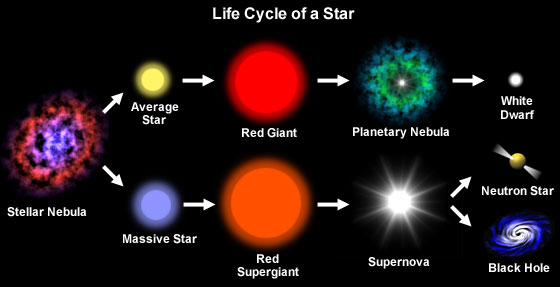Preconceptions
(standard misconceptions on your topic)
All stars are the same
The sun is not a star
Stars live forever
Stars are made of fire
Stars are pointy-shaped
What
is the current science understanding?
Every star begins as a Stellar Nebula. From here, the nebula can go one of two ways: A (top track of picture) and B (bottom
track of picture).
Track A: like our Sun, stars of similar size undergo this lifecycle. Eventually, the star bursts into a Planetary Nebula and into
a White Dwarf, how it will spend the remainder of its days.
Track B: this is the life cycle that larger stars undergo during their lives. Towards the end of their life, they will explode into
a Supernova, and their remains will be scattered around the cosmos (National Schools Observatory). From the explosion,
what's left of the star can either become a Neutron Star, spinning through the galaxy, or a black hole, absorbing other cosmos.
Other:
What
was the historical version?
Historically, it has been believed that stars are formed in clouds of gas and dust and form each stage of the above diagram
through condensing, expanding, and exploding.
Cool
facts (addressing the misconceptions listed above)
Each star has a different mass, brightness, temperature, size, and color. Depending on its mass, the star will take
one of the two routes discussed above.
The sun is a star because of what composes it (primarily hydrogen, helium, and small amounts of other elements.)
and its size. Stars have to be able to emit a certain amount of light to be classified a star and not a planet.
Stars do not, in fact, live forever. On average, stars live to be about 10 billion years old. This lifespan varies based
on size, mass, and its elemental composure.
Stars are made of helium and hydrogen, and create heavier elements later in their lifetimes.
Much like how our hearts are not heart shaped, stars are not pointy-shaped. They are spherical balls of plasma, but
because they are so far away our eyes trick us into thinking they have points.
How
would you consider teaching this?
I would consider teaching this by first explaining to the students that much like how each sport has a different ball and
purpose for the ball, so do the planets and solar systems in the Universe. Each solar system (sport) has different balls
(planets) and sizes of balls that each have a different purpose and amount of time in which they can be used. For example,
soccer balls come in different sizes. Smaller balls are for you to work on your footwork and control of the ball, while larger
ones are to be used when you have mastered the basics and wish to work on various skills/moves in a way that resembles the
game better (you wouldn't use the smallest size soccer ball in a game against adults).
Similarly, our solar system has 8 planets that each have different masses and purposes. While Earth's purpose is to inhabit
life, more gaseous planets (like Saturn) are not. Not similar to soccer balls, however, one does not "graduate" to a bigger
planet when they have "mastered the basics".
